In the second installment of a series devoted to real Chicago places and people, I talk with John Veliotis, of Bridgeport hot dog stand and neighborhood center Johnny O’s, sharing stories of the old neighborhood and looking at two unique South Side treats, the Mother-in-Law and the breaded steak sandwich.


There was an article in Slate last week* about how your foodie-ism is an awful snobbish vain planet-destroying thing. Okay, I know, I know, the easiest freelance sale on earth is something contrarian and attention-getting to Slate, like “Why Your Oxygen Addiction Is Killing the Atmosphere” or “Attention Boy Scouts: Actually, Busy Traffic Is Good For Little Old Ladies.” And too often this kind of Puritan deploring of modern habits is vanity in disguise, the modern equivalent of the medieval flagellants who would beat themselves the hardest in public for the attention, declaring “I am the worst of all!” You wish.
Take a statement about trendy farmer’s markets like the following:
It used to be that human ingenuity was valued in the kitchen. Now, what matters more is chefs’ knowing the right producers and buying the right products. Culinary excellence can no longer be achieved simply by learning the right technique; it can be acquired only by knowing the right things to buy—and by, it needs hardly be said, shelling out however much money it takes to buy them. In this way, modern foodies’ materialistic definition of refinement is more exclusive than that of yesteryear’s dogmatic French cooking. What appears to be a celebration of the natural and the simple is in fact more constrictive and less attainable, because it depends not on talent but on means and access.
This is complete insanity, an argument only possible if you know NOTHING, absolutely nothing, about the brutality and forbidding class divides of the classical French kitchen. Remedial reading of Henri Charpentier’s Life a la Henri is recommended. But it also seems to know nothing life as it’s actually lived in 2013, either, because it imagines this world in which chefs and diners are one-upping each other over the provenance of carrots, apparently. And honestly, they are? Who, where? I want names and addresses, because I keep hearing this stuff about these awful entitled annoying locaboors and farmer snobs, and I just don’t find them in real life, anywhere.
I was thinking about this while I was at Sous Rising, an underground dinner experience put on by chef Jake Bickelhaupt and his wife Alexa, which I first really heard about when he was picked to do this Key Ingredient:
That’s his kitchen, and we ate at their table, seven of us, and it was just such a warm, and kindly, and eager to please experience, a communal experience of delight, that it’s simply impossible for me to reconcile a dinner like that with the pinched, sour, grasping notion of modern dining that the Slate piece would have you believe is inevitable now.
Bickelhaupt is young and earnest, like John Cusack in Say Anything, has some fancy experience (Alinea, Charlie Trotter, Schwa) but is also kind of inexperienced in a good way, in that he doesn’t come off like a lifer in the biz already— he’s more like Iliana Regan of Elizabeth, he knows what he wants so much that practical experience is only a small piece of who he is, really. And in any case, the last thing you’d ever say is that he doesn’t know what he’s doing in the kitchen— he and another chef did everything, with hardly a word, turning out something like 21 courses in a standard apartment-sized kitchen, about 4 feet behind my back, and every time you looked at the kitchen, it looked as clean as if they hadn’t started cooking yet.
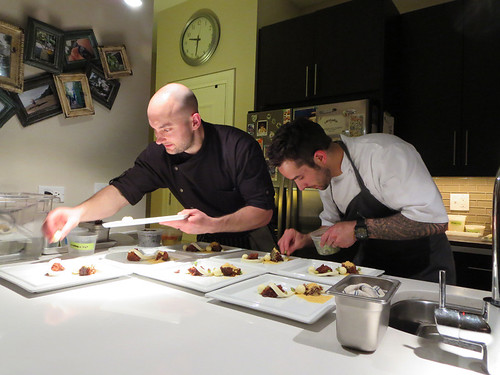
The food, I suppose, came closest to Schwa, there’s a lot of tricky stuff in it as in this “cocktail” which froze one liquid and gelled the other:
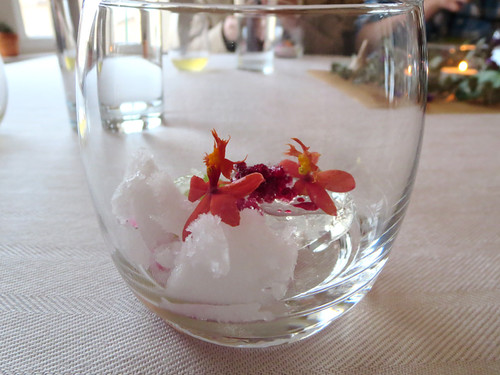
but things were also just plain beautiful, delicate, no matter what music was headbanging in the room at the time. And there’s not only a lot of skill but a pretty good understanding of what people enjoy that goes into a dish like this:
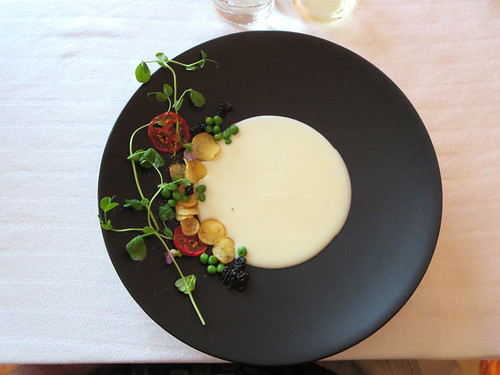
basically, a soup made with the flavors of caviar and potato, including the little fingerling potato chips and the dried tomato slices. It’s pretty, it’s local (note the pea tendrils, on everything this week), and unlike the deconstructed version of this caviar-potato dish I can imagine having at many places, it tasted great, a warming, nurturing dish.
There was maybe one dish I thought was a botched modernist experiment— parmesan puff crisps for scooping up parmesan foam, which sort of crossed the line from cheese smell to puke smell. And I’m going to say right now, this thing of making savory-sweet main courses with cake in the middle of them doesn’t work for me— everyone else was delighted by this duck confit-duck crackling dish in a garden pot, but I wanted something more robust and meaty at that stage in the meal than this:
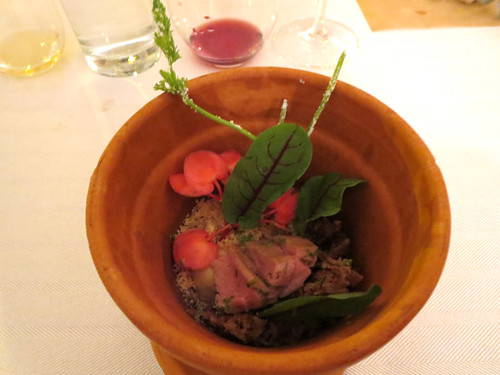
But that’s two out of 21. Then there was this amazing combination of tart, jarring tomatillo broth with delicate peekytoe crab:
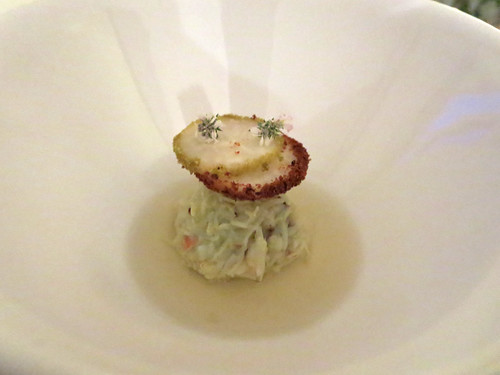
or this sugar-cured beet, as gnarled as a prune, topped with a bit of anchovy and dill:
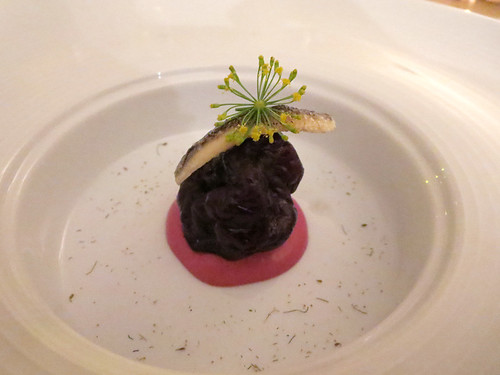
Bickelhaupt said it was his tribute to his Scandinavian ancestry and most guests hated it, but I loved its Nordic plainness mixed with the surprising lushness of the pickled, but not vinegary, beet.
I could go on course by course, but I wouldn’t want to spoil the surprise, and in any case, it’s sort of not the point, I don’t want to do 7 THINGS YOU MUST EAT AT SOUS RISING RIGHT NOW, because in so many ways it wasn’t about the food in a list-the-ingredients sense, certainly not in any my-carrot’s-morally-superior-to-yours way (though I will say that Bickelhaupt seems to have no trouble getting hold of the same things big name chefs use, mostly just with a phone and a credit card). It was about the pleasure of experiencing someone else’s pleasure at making food for you, and the shared pleasure at the table as we had each new thing set in front of us. It wasn’t an entirely new experience— you could analogize it to Schwa, to Elizabeth, to EL Ideas, and to my first dinner of this sort so long ago when Trio in Evanston had just gotten a new young chef named Achatz in who was doing crazy things. Maybe something in fine dining has gotten a little too pinched and status-driven at times, though I’d blame media at least as much as chefs for looking at food in terms of gets and firsts and musts. But all it takes for all that to melt away is one chef to welcome you into his space and make delightful things for you. Well, two chefs and a server-slash-wife— this was, as much as anything, a meal suffused with the happiness of two people who are happy at home:
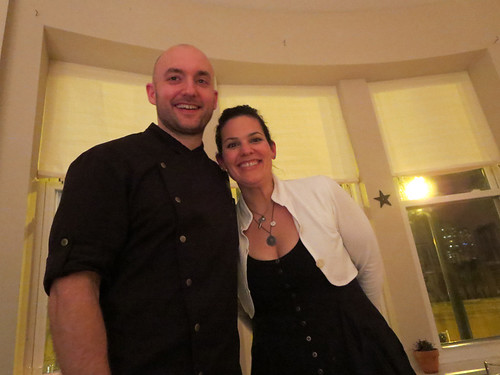
A restaurant is rumored and, surely, inevitable. It will change some when that happens, but in the meantime, go here and book yourself a place at the table of the apartment on the top floor, left.
* Between the time I started this and when I finished it, Whet Moser wrote this excellent piece taking the Slate article down in more detail.
* * *
One son had to be in Glenview for a 4-H meeting. Which gave me just enough time to grab sushi. Wait, why do I associate Glenview with sushi, you ask? Isn’t it a pretty whitebread north shore suburb? Maybe, but all I know is, there’s a cluster of sushi places there. Akai Hana is right off the 94 exit at Lake. Others are a mile away on Waukegan Road. And these aren’t new, trendy, lame-o sushi places for hipsters, but places that have been around for a number of years, mostly Korean-run (like most sushi in Chicago) and aimed, it seems, at an Asian audience.
One called Tatami seemed the most promising and once I circled Waukegan Road three times to find its location at the back of a strip mall, invisible from the street, I knew it had to be good. It’s a small, slightly dated-chic dark room; two chefs stood at the counter, talking in Korean (I assume) to a couple sitting there. Unfortunately, that meant I never had a chance to engage the chef directly to give my standard spiel for wanting him to pick me good stuff that wasn’t all tuna and salmon, and the options for ordering proved pretty thin— there was a $30ish plate that I was warned would be all safe stuff, or a $70 platter for two that had more unusual stuff like fluke or needlefish on it. I seemed to have no choice but to order enough sashimi for two.
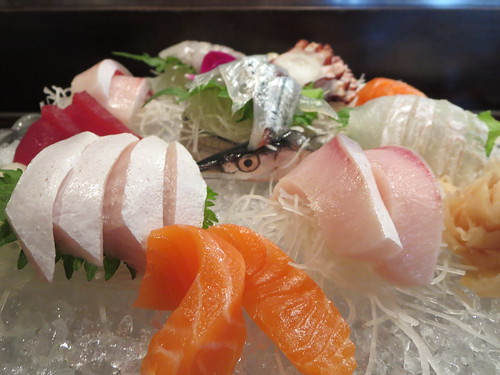
So yes, I ate way more sashimi than I needed to, and to some extent I paid for it the next day, I suspect, because I strongly suspect one of the white fishes was actually escolar, a tasty fish but one known for, shall we say, a castor oil effect. And there was a lot of each fish. That said, I was really impressed by the quality, and if I’d had, say, 60% of this amount of fish for $45, or if there was another person to split it with, this would have been a great deal, quality approaching the best places in the city for substantially less; next time I’ll force my way into a conversation with the chef and get what I really want. But as it is I liked the delicate, supple fluke, the nearly translucent, ultralight needlefish (whose spine was used to make a ring to hold the bed of daikon it sat on in the middle), red snapper, salmon… nothing fancy or filigreed about it, just straight up fish of good quality. A find in that area, for sure, if you can find the name on the strip mall’s sign and know you’re in the right place, that is.
Tatami Restaurant
1859 Waukegan Rd
Glenview, IL 60025
(847) 998-8887
http://www.tatamichicago.com
* * *

I popped into Little Goat Diner for lunch on a Monday and snagged the last seat at the counter. It is amazing that through sheer star power and, it seems, an unabashed willingness to make juicy fat food, someone can open a coffeeshop, with decor that echoes the 70s (not the retro chrome diner 50s but the beige coffeeshop 70s, like a Greek place in Lincolnwood called Omega doing omelets or something), and absolutely pack the place.
I ordered the kimchi reuben because, believe it or not, it seemed one of the lighter items. As I saw enormous things like the sloppy joe or whatever it is above come out, it seemed downright dietetic.

Here’s what I found funny. Some people have accused Little Goat of basically being stoner food, pile-everything-on-and-stuff-yourself food. But the logic of a kimchi reuben is perfectly clear— substitute one kind of pickled cabbage for another and take it in a new direction while retaining what the reuben’s primary dynamic is. Fair enough, except… they didn’t substitute. There’s sauerkraut on there. There’s an entirely (quite good) reuben on there, and then there’s kimchi on top of it. Which to me seems almost unfair, unsporting— you could just pile anything on there, pulled pork or pickled beets or vanilla ice cream. Give me a side of mac and cheese and I’ll make a mac and cheese reuben at my seat. The point was achieving a kind of chef alchemy in which you traded one cabbage for another and made something new and Asian-hot that still had the Aristotelian unity and economy of the original.
It’s the only thing I tried so I have no deeper thoughts than that— I just wanted some cheffy Steffy magic out of this dish and it turned out to be more conventional, philosophically, than I expected. Though it is, still, a pretty good reuben.
Tags: jake bickelhaupt, sous rising, underground diningThe Green City Market opened at its outdoor location Saturday with the relief of somebody busting open the windows for the first time in months. Sometimes I have to drag my sons to it but this time they seemed eager to go— a chance to taste old favorites they haven’t had for months. I also told them that if they wanted to bring their cameras, I’d post their pictures, and so, when their hands weren’t full of food, they snapped away, Myles the 14-year-old with his Canon PowerShot SX40 HS, Liam the 11-year-old with a brand new Canon Elph 330 I picked up as a new pocket camera (I have a DSLR for my better photos, but it’s always useful to have a little one to carry around, too). Anyway, here’s what they chose to look at at the market, which was pretty well picked over by the time we got there around 10:30.

Credit: Liam.

Credit: Liam.

Credit: Myles.

Credit: Myles.
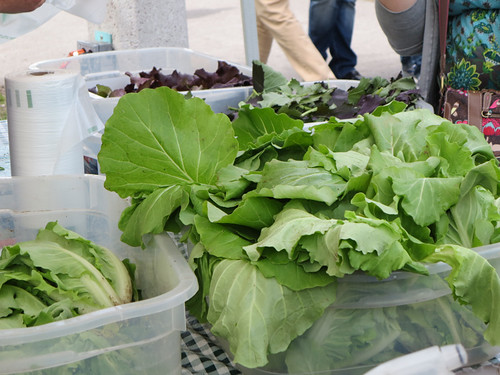
Credit: Liam.

Credit: Myles.
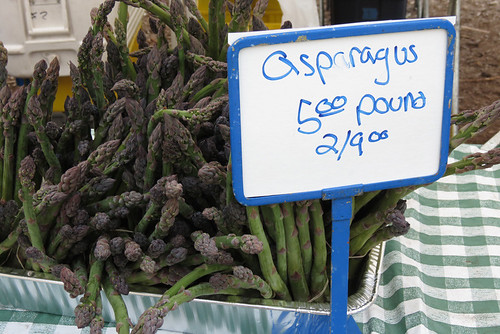
Credit: Myles.
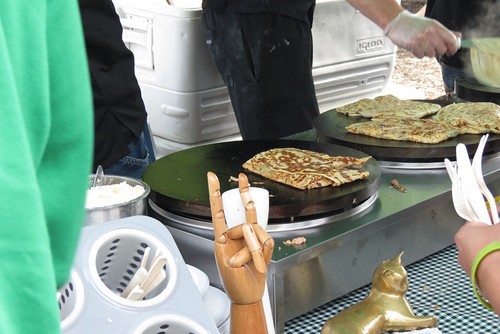
Credit: Myles.
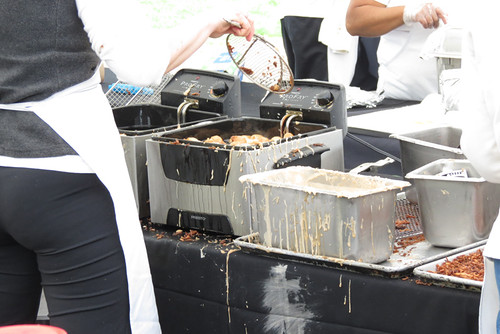
Credit: Myles.
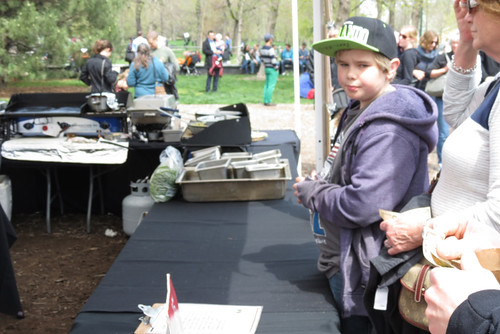
Liam waits for his zeppole. Credit: Myles.

All out of hand pies at Hoosier Mama. Credit: Liam.

Credit: Myles.
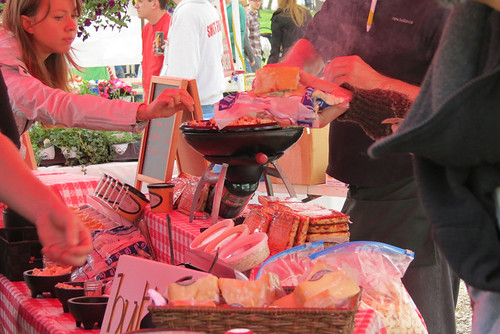
Credit: Myles.

Credit: Liam.

Credit: Myles.
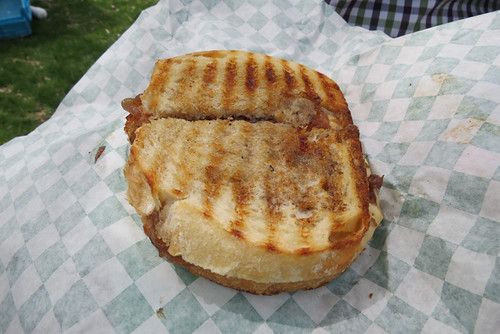
Credit: Myles.
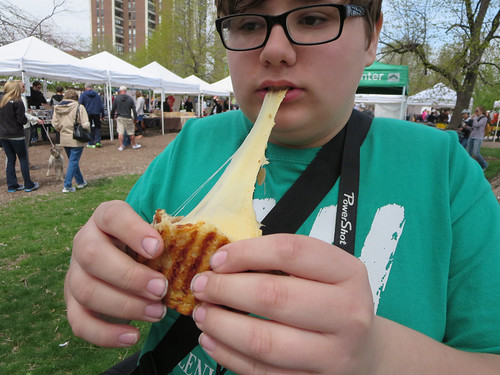
Credit: Liam.

Credit: Liam.
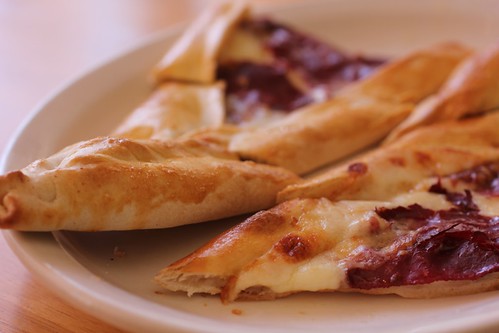
Pide at Pide ve Lahmacun.
Other than shooting a Key Ingredient there, I hadn’t been back to Fat Rice since opening night, but there we were at home on Friday night, all in one place and hungry at 5:40, so I knew what we had to do was jump in the car and be there when the restaurant opened at 6— before the lines, which are supposed to run up to two hours these days, became hopeless for a family with impatient kids. A few months ago I found Fat Rice promising but not yet something that could change my ideas of Asian food— not the Chicago answer to Momofuku or Pok Pok or other hot Asian places around the country. It shouldn’t be something one worries about to wish we had a place that scored on the food-hipster scale like those do, but hey, we have civic pride, just ask Rachel Shteir.
Or take her to dinner at Fat Rice, which is fantastic and might just change her whole outlook. Asian fusion is often just Asian food minus the funkiness and with the sweetness dialed up. It’s a form of upscaling ethnic food that basically trashes it. Not at Fat Rice, which reaches into one of the original Asian fusion cuisines— Portuguese-influenced Macanese (Macau) food and finds a cuisine that has the brightness and funkiness of Asian mixed with the deep earthy slow-cooking virtues of European peasant food from Spain or southwest France.
The best dishes, like the eponymous Fat Rice, are deep and dark, dotted with funky sausage, dishes you could burrow into for the whole winter. Others, like the chili clam with fried and sashimi clam on chilis and glass noodles, are nimble, as light-fingered and fresh-tasting as anything at Arami or, for that matter, L2O. Even fairly conventional dishes, like the pot stickers (which come as a single piece attached by a crepe-like skin) or the pepper steak with coconut rice, light up your mouth like a Christmas tree with bright flavors of fresh vegetables and meats that instantly set them apart from the muddle of the conventional Chinese-American food they might resemble at first glance.
Not to be confused with the farm to table restaurant of the same name on the roof of Roots Handmade Pizza, the Homestead at 6144 N. Lincoln is a cute little breakfast and early-bird dinner comfort food place whose country decorations and welcoming air seem to have come straight out of a small town cafe in downstate farm country. The staff is sweet as can be, the restaurant is squeaky clean, and the food is maybe a little too squeaky clean if, like me, you like a little funk and soul in your diner food. But they bring you homemade chicken soup before Sunday breakfast (and it’s probably the best thing here)— c’mon, the whole place is adorable.
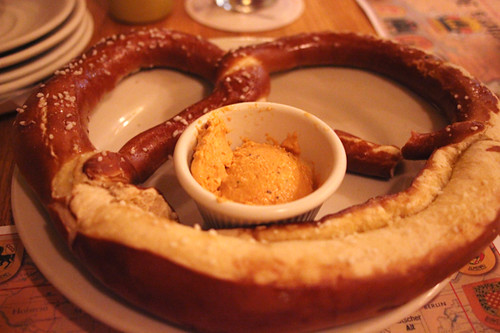
Laschett’s Inn is walking distance from my house, yet I hadn’t been there since a meal commemorated on LTHForum in its early days. That is, I’ve tried 3 or 4 times and had an endless run of bad luck— they were open but not serving food, they were closed for a private party… whatever. Finally went with my sons and found, from the menu, that they had an expanded back area and another set of new owners (at least the second set if not more since Karl Laschett took over an even older business, apparently). Still, it remains one of the best examples of an authentic ethnic restaurant in town; it totally captures eating German food in… Milwaukee, with a supper clubby feel and waitresses who not only call you “hon” but are downright overflowing with gemütlichkeit.
Starters were great— the giant freshly-baked pretzel with a tart cheese spread made of camembert and brie (and cheddar, surely, to judge by the color), and the hearty, satisfying goulash soup (a dollar upgrade when they ask you “soup or salad,” and well worth it). So it was a bit of a bummer that main courses took German heaviness a little too far— Wienerschnitzel was coated much more thickly than at Resi’s across the street, the frikadellen beef-pork burger seemed a bit dried out, while the potato pancakes ought to have been crispier. It’s still a charming slice of a Chicago that existed into the 80s and early 90s, but set your expectations more for hearty good time than culinary distinction.
A more exotic act of ethnic recreation takes place at Pide ve Lahmacun, a new Turkish restaurant at Irving and Ravenswood. Actually two new Turkish restaurants, there’s another storefront called I-Cafe but you can have the food from either one at the other. I don’t usually play the “This is just like the feng shui we ate in Yokohama” game, not being the world traveler some are, but having been to Cappadocia, I can say that this is just like the food in Cappadocia, because there are only two things to eat in Cappadocia and pide was one of them so I had it several times. What is pide? Basically it’s Turkish pizza, football shaped and topped with cheese but not tomato sauce, and often eaten with very salty air-dried basturma (pastrami) on top. Is it better than the pizza you normally get delivered? No, but it’s pretty good, and so are the other things they have— their version of Iskender Kabob (doner meat, tomato sauce and tangy yogurt) was bright and flavorful too. But my son and I went there to eat pide, and for a moment, we were members of a secret society remembering the strange thing we had eaten in our travels in the east. Remembering it exactly, in fact.
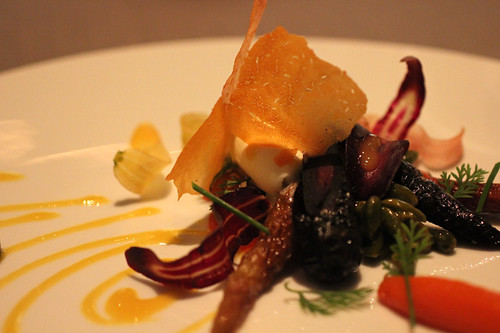
Running a lot of photoshoots from contemporary restaurants, as I do at Grub Street, I see trends I didn’t really notice before, and one is that how food is plated has changed tremendously without, really, anyone talking about it or even having a name for it, so far as I know. I call it the sprawl— it’s when the food is arranged in a line or a loose S-shape on a plate with different ingredients and garnishes and sauces plopped along the path. Well, not exactly plopped, since it’s often arranged very carefully with tweezers. But the point is, it doesn’t look at all like food has ever looked before, that kind of random-seeming scattering of food on the plate. Instead of a distinct thing— a dish, like moussaka or steak au poivre or chicken and waffles— suddenly, everywhere at once, you have this display of disparate parts, like the exploded view of a mechanical device for you to put together on the fork (and in your head). How did that become the way we eat now?
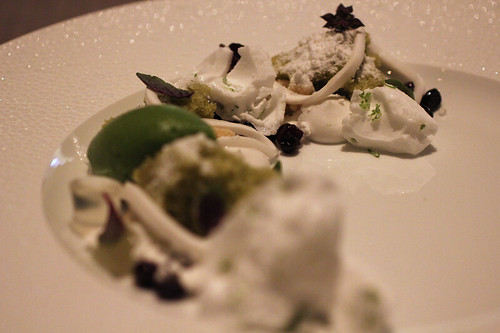
I think you can see it as a logical point in the evolution of fine dining. In the 90s we had tall food— a puddle of puree, the protein on top, more stuff piled on top of that. Then we had the tasting menu with its many small courses— but small things plated the same way prompted jokes about tiny food on a big plate. And so now we have the sprawl, scattering the parts across the plate to take up more real estate and produce the excitement of the hunt— each bite will turn up some new combination of the things scattered on the plate.
Or, maybe it just turns every dish into a salad. That, I think, is the risk— raw or lightly cooked vegetable material tends to dominate even when the focus of the dish is supposed to be an expensive slab of luxe protein. Anyway, I was thinking about all this, because— well, I ate the vegetarian menu at Grace (the menus are “Flora” and “Fauna”). I did, really? Me, celebrator of meat, guanciale curing in my basement right now? Yeah, but I have nothing against vegetarian food when it’s made by someone who is making vegetarian food, not merely leaving meat out of food (or, gad, putting something fake in for it). I was curious to see how a meal at this level could be made without meat. (I was emboldened to be so curious about a meal at this price level because— disclosure— I was a guest of the house. I probably would have chickened out of such an experiment on my own dime, given Grace’s four-star-level cost.) Can you do a meal like this entirely out of vegetables and make it as satisfying as the usual tasting menu circa 2013, or is the absence of meat protein too obvious? And if you can do it… can you do it in February?
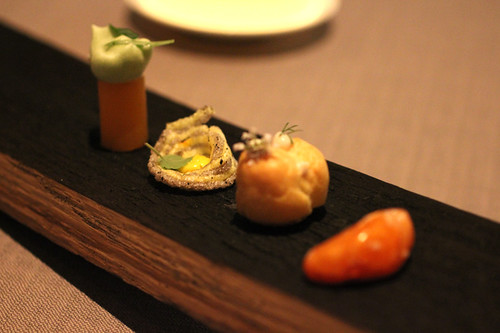
The meal started with a few bites served on a long charred barrel stave, which arrived at the table like a brontosaurus rib. The bites, however, were delicate and intense— I especially recall a single mandarin orange slice, lacquered with paprika-flavored candy. These were little bites of magic, new flavors invented at the moment of tasting. The carrot dish that followed— pictured at top— was a sprawl doing everything you’d want it to do; the aged carrots had concentrated flavor, accompanied in turn by a new sauce and a new taste every time you lifted a piece and found the next little blob of goo. It’s a delightful dish— and, I found out later, one that’s been driving the kitchen nuts; it was mentioned in Kevin Pang’s Tribune article about chef Curtis Duffy’s personal history, and so even those who order the Fauna menu want to try it. For a while they were sending it out as a courtesy, then they were charging extra for it, but either way, Duffy observed bemusedly to me that they felt like they were spending half the kitchen’s energy on the damn carrot dish and he was sick of it already.
In my last Grace video Duffy talked about how, during winter in Chicago, you have to reach beyond the city to find things that are growing. Yet many of the courses were almost defiantly wintry, daring you to find enough sustenance in winter’s foreboding, like this Goth dish of cauliflower, black sesame, quinoa and opal basil:

or this musky plate of maitake mushroom and preserved daikon, with coffee:
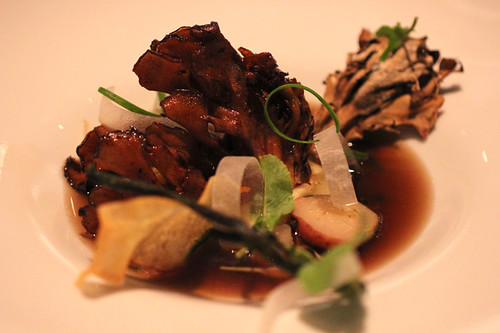
Throw in a bowl of chestnut and truffle slices and you have a serious exploration of winter’s hard-won bounty, rendered into as much luxury as can be managed so monochromatically. But then I looked over and saw my wife was eating this:

It wasn’t just the riotous color of this Scottish salmon dish, though it was gorgeous, but by now, halfway through the menu, I was missing the contrasts that animal protein would have brought to the meal— the lush fattiness of that salmon, the salty, iron-y physicality of red meat, the brine of roe, all those things. Duffy cooks mostly vegetarian either way, but it turned out that for me, the difference between mostly vegetarian and entirely vegetarian was a huge one. Vegetables on their own— even when we were talking such voluptuous things as chestnuts and truffles— didn’t have enough variety. Maybe they would in July— the flora menu would be an explosion of green and bright fruit flavors then— but for me, I needed at least a hint of carnality to make this meal complete. (Serendipitously, right about as I was feeling this way, Duffy sent me the latest iteration of the kobe beef and mushroom dish which I had tried during the shoot for the last Finding Grace video. Now that’s my kind of vegetarian meal!)
I don’t go into this level of course-by-course detail with the intention of suggesting any dissatisfaction— merely to answer the question which has usually come up when I tell people I had the vegetarian menu, which is, was it worth it? Well, worth it in terms of creativity, ingenuity, artistry? Yes, it’s captivating to watch Duffy produce dish after dish which looks like nothing you’ve seen before. The “sprawl” here gets twisted and rejiggered and reimagined with every course; he’s plainly ahead of anybody else in town in that regard, plating with an abstract complexity that even the most exquisite sprawl-makers don’t rival. But for me, carnivore that I am, and winter as it is, an all-vegetable menu in February was like an orchestra without brass; it didn’t need much, but there’s something that woodwinds and strings alone can’t get to. Again, maybe that wouldn’t be true in summer, or maybe not for you, but it was for me that night, and the vegetable dishes got more interesting when I managed to have a bite of salmon or beef. (Beyond that, I have to say, especially after dining at L2O a while back, I was really curious to see what Duffy would do with more fish on the menu— I think of the most delicate tastes of the sea I had there, and they seem natural fits for Duffy’s even more delicate vegetable-driven menu.)
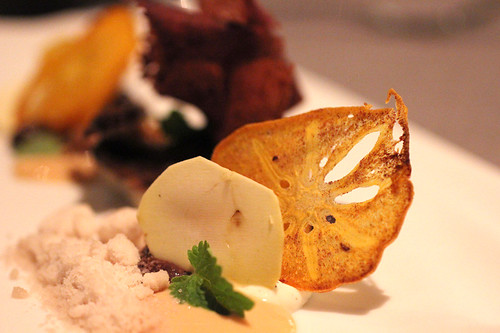
In any case, it’s impossible to have “I should have done X” thoughts as dessert— a full third of the menu, including mignardises at the end— makes its way out to you. Each of these plates was like a windup toy, bringing you color (even the monochromatic coconut and lime dessert at top) and playful surprises— frozen cranberry spheres (oh, go ahead, say it, DIPPIN’ DOTS) on pine ice, pumpkin and chocolate and what looks like deep-fried silly string, tiny twirls of pear set in elderflower goo— it was one showstopping burst of imagination after another.
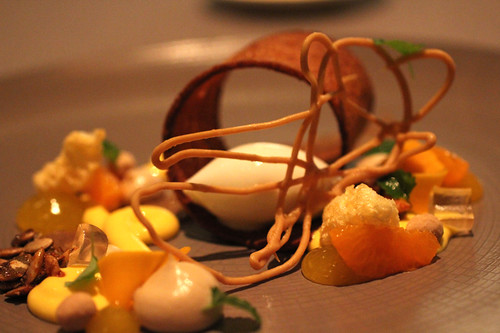
And it is perhaps time to bring the theatrical metaphors in, because as much as one may talk about the food, on some level Grace may be the first restaurant fully built for our sense of dining as the performing art of our age. It’s not just that the illuminated kitchen behind its big rectangular window resembles a movie screen (and Duffy a movie star, as Mike Sula noted), but the tables are arranged to face it during dinner, like parked cars at a drive-in. (When I ate here last week, I immediately thought— just like Grace!) And it isn’t a matter of only known foodies getting a chance to go behind the screen to meet the chef. A kitchen visit is simply assumed as part of every dinner; you’re here, by definition you want to meet the chef and be allowed in his gleaming white 2001-spaceship of a kitchen. Why pretend you’re not a foodie-groupie?
So what tone does service set in such a new environment when it’s aiming to be world-class? Go too old school, and you evoke an era of aristocracy that would never have wished to see the kitchen in their lives; get too informal, though, and the fatcats who can afford this kind of meal won’t feel sufficiently deferred to. Michael Muser’s service team manages to square the circle with service that’s as precise as the chefs in the kitchen but affects informality— “What I really like about this wine is…”, that sort of thing. Which is kind of a funny place for ultra-high-end fine dining to be in now— the masters of the universe, the guys with the mostest, nonetheless looking to blue collar servers for guidance to the really good stuff. (True, they always looked to the sommelier that way, but he was an accredited professional with a title, like a bishop.) The old class distance between the moneyed and servers still exists— at least it sure as hell existed at Trotter’s when I went shortly before it closed— but the rules of engagement between diner and restaurant for the 21st century are being worked out in Grace’s hyperaware yet unfussy, practicedly relaxed service.
* * *
NOTE ON THE FOLLOWING: My dinner visit was a while back and I’m told you can now order any damn thing you want on a pizza at Reno.
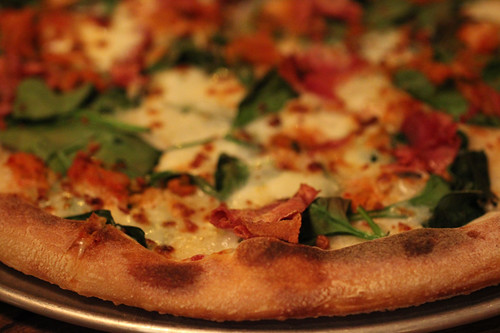
Edward’s Ham, Kimchi, Spinach, mozzarella, fried garlic pizza.
I’ve been to Reno three times, once for each meal: bagels for breakfast, a sandwich with my kids for lunch, and woodburning oven pizza for dinner. Okay, so why am I writing about these meals at the same time as the hoity-toity meal above? Because I think there’s also something about the way we eat now at this much more modest place— something about the way we look at chefs and the experience they provide us.
Reno comes from the restaurant group that also has Telegraph, Webster’s Wine Bar and The Bluebird, and like a lot of restaurant groups, its ambitions have risen with each new place; Telegraph in particular has seen acclaim for chef Johnny Anderes’ pastas and other dishes (and I’m happy to share the general praise). I would still call the acclaim for Telegraph rational, as opposed to the hype for Reno, whose general theme was OMG THESE ARE THE BEST EFFIN BAGELS IN THE HISTORY OF CHICAGO.
Well, okay, they’re quite good bagels— allegedly Montreal style (I can’t tell you how accurately), little handmade rings baked in the woodburning oven for a very slight smokiness, and one will cost you about as much as a half dozen at any prior bagel shop. The sandwiches are good, the pizzas are good. It’s all good, if not OMG BEST EFFIN good. It’s a credit to the neighborhood.
But what I notice about Reno is that the menu is really short. And more than short, it’s quirkily short. There are flavors of bagels you’ve never seen (Olive & Herb) and you don’t see ones you expect to see (onion, garlic, cinnamon raisin). There are about seven sandwiches, and they include things like chicken thigh or pork carnitas… but not ham and cheese, say. Most of all, the pizzas are definite creations with lots of very specific toppings— you can get a pepperoni-jalapeño pesto pizza, or a pork belly carnitas-salsa-verde-mozzarella-rajas-cotija cheese one, or a butternut-squash-sage-gruyere-cheese-walnuts one, but not, oh, sausage and mushroom. Or pepperoni without jalapeño pesto, for that matter, unless maybe you order it Jack Nicholson in Five Easy Pieces style.
Okay, so it’s cool that they have all these interesting combinations, like there aren’t 10,000 other places to get a ham and cheese sandwich or a sausage and mushroom pizza in this town, you say. True enough, at least when the combinations really work— I thought kimchi obliterated every other flavor on the Edwards ham pizza, for instance (though curiously, the other flavors asserted themselves better the next day as leftovers). As a solo diner, okay, if the chefs want to take us on a quirky journey, I’ll buy into their vision and eat only what they want to make. As a parent, though, it makes it harder to take kids— or grandparents or a lot of other people I know— when the choices are so limited to cheffy creations like that.
Well, okay, they’re in Logan Square and their target market isn’t exactly the same as a family pizzeria. Which is my point. At one time, a very short time ago, dining according to a chef’s exacting vision for your meal was restricted to very high-end, self-consciously artistic meals at places like Grace. (Five minutes before that, chefs didn’t have artistic visions, just skills.) Now it happens at the pizza and bagel place on the corner. That’s just the way we eat now. And if there were things that you wanted changed to your personal tastes— I have the feeling that the lofty fine dining place would be quicker to change them for you than this pizza place on the corner.
* * *
A final note: the secret of so much food journalism is the PR person behind the scenes connecting restaurants and media people; the non-media reader normally only spots it when it’s done clumsily, which means the ones who do it intelligently and, well, gracefully are too good at their job to be noticeable. But I want to call attention to the role of Jennifer Galdes, who was the pivotal person in convincing me to do something about Grace— which proved to be my widely acclaimed video series, linked above— and at the same time, in convincing the decidedly cautious Curtis Duffy to open up the process of launching Grace to me. Her steady, unpushy handling of Grace as a client was essential to its successful debut as one of the year’s most noteworthy restaurants nationwide, and I am grateful for her involvement with it— and me.
A couple of months back I had the privilege of introducing a friend of mine and a well-known figure on the food scene, to another pair of friends of mine… also well-known figures on the food scene. They hit it off well and found many points of compatibility, and so I’m excited to be able to share their news with the world today.
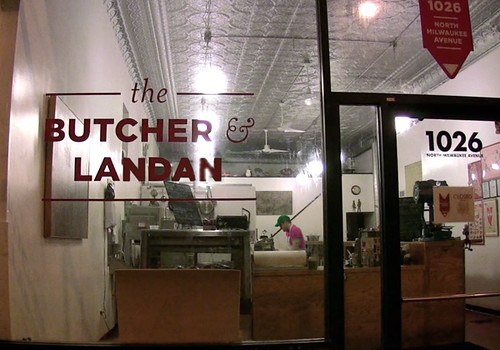
Chicago’s beloved butcher shop The Butcher & Larder is going in a new direction in the next few weeks with the addition of two new partners to the team of Rob and Allie Levitt. They are Jon and Andrew Landan, the twins who have become renowned for their tireless work promoting the Chicago social scene. The revamped shop, The Butcher & Landan, will continue its dedication to farm-sourced, naturally-raised meats, but at the same time will add features reflecting the increased popularity of whole-animal butchery on the social scene, such as an on-premise DJ, Ladies’ Nights, and bottle service in “Protein,” the shop’s new second-floor lounge.
Says Rob Levitt, “We are totally, one thousand percent devoted to giving you the most awesome meat service imaginable, including curated sausage flights and private roasted offal salons. At the same time, I’m tired of cutting meat all day and looking forward to being able to balance that with the all-night party that Alli and I dreamed of our shop being from the moment we opened it.”
As for the Landans, whose interest in nose-to-tail cooking and whole animal butchery has long been known on the club scene, they’re excited about adding meat to their portfolio of exciting nightlife activities. “We looked at how much we were spending on the gym,” said Andrew, or possibly Jon, “and said why do that when we can haul half carcasses from Q7 and Slagel back and forth in the store and get the same workout?”
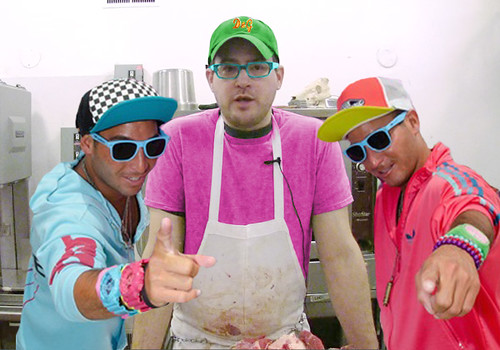
The newly revamped shop expects to kick off with a VIP party in late April. To learn more about the concept, watch for the upcoming Sky Full of Bacon video “The Fabulous Butcher Boys.”

Lots of busy things happening, but at Grub Street and the Reader, not here.
I interviewed the lovely Nigella Lawson.
I told the story of an old school Italian place and its dedicated owner.
I got nice words from Rick Bayless.
I’m big in Japan England: Sky Full of Bacon videos are running on a public affairs satellite/cable channel in the UK, and I’ve gotten several nice comments from viewers over there.
I tried to explain what Indonesian food is about.
I interviewed the charming Fabio Viviani:
I shot a cool bar 18 stories up:
And here are the Key Ingredients since the beginning of the year:
Matt Kirkley of L2O with warabi starch, making a fish ball out of a Japanese dessert:
I love when chefs get something totally plebeian: like celery for NoMI’s Ryan LaRoche:
Someone was bound to get durian eventually, and it was Lee Wolen of The Lobby:
Wolen gave another Asian fruit, buddha’s hand, to Gaetano Nardulli of Near in Barrington:
Noah Sandoval, who as you’ll see has already been in the background of a past KI video, with chestnut flour:
And for the first time, we unmistakably kill something on camera: lobster tamalley for underground chef Jake Bickelhaupt (Sous Rising):
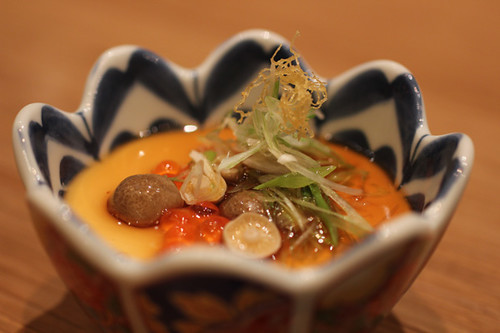
I have written here more than once of one of my favorite New York dining experiences, maybe the only place that would get me to utter the dread phrase “Chicago doesn’t have a [blank] as good as [name] in New York”— Yakitori Totto, the second floor walk up kinda divey totally awesome yakitori/izakaya/robata place. I don’t expect to ever find its exact equivalent, since you can’t open a new place with a been-around-for-20 years vibe, by definition, but I’ve held out hope that someone could at least make robata items as interesting and varied as what Yakitori Totto grilled on its tiny bincho grill.
Which is one reason I took an interest early on in the impending opening of Sumi Robata Bar from Gene Kato, long of Asian glitz joint Japonais. But Kato was serious and focused about his craft, as this video I did suggested:
Like that other guy I was making videos about at the same time, Kato was determined to create a working space to his exact vision. Which, as it turns out, starts in the basement in the other half of the restaurant:
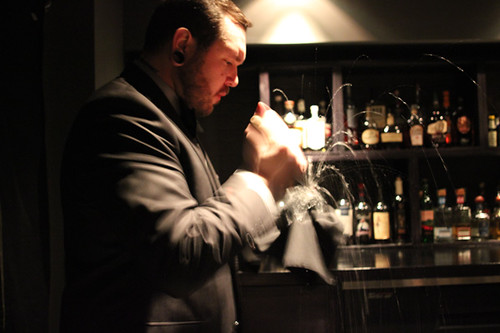
The basement is called Charcoal Bar, a cozy little black-walled inner sanctum. Like The Office at Next/The Aviary, it’s a bar trying not to feel like a commercial enterprise, and while I have no great need for insider exclusive experiences, I was instantly won over by the intimacy of this little space where (if you snag one of the six bar seats like I did) you can just hang out with mixologist Matthew Lipsky as he does crazy things like chip a perfect ball of ice for his Old-Fashioneds. That was actually someone else’s drink; I ordered one called the Narcissus, which combined aged rum with a whole egg, among other things. As he was straining it it looked like pancake batter, but the creaminess of the egg and the fruit and alcohol blended into a remarkably light yet wintry drinks, one of the best cocktails I’ve ever had.
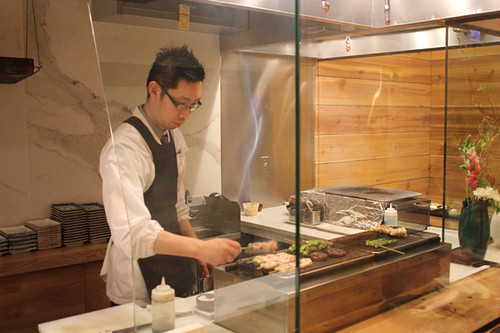
Then it was upstairs to Sumi, where Kato and sous chef Justin Romine make delicate little things for you. Not all are grilled; some of the best were just simple cold things, like a cured cucumber which was crazy good (Anthony Todd said he wished bars had that instead of peanuts to build up your salt thirst for beer) or the housemade tofu with salmon roe, a gorgeous little bowl with creamy tofu that was almost like butterscotch pudding.
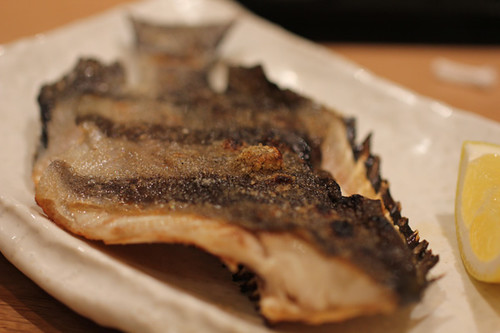
But the grilled things were all pretty wonderful, too— a miso-marinated lamb rib, offal like chicken gizzards (alas, they were out of chicken tail that night), vegetables like shishito peppers or asparagus. We wound up taste-testing a fish they’re thinking about adding to the menu, I forget the exact Japanese name but it was a beautiful little round white fish whose skin crisped up fantastically:

Even the thing that seemed kind of sheer audience-pleasing, a slider consisting of a sausage on a bao bun, was startlingly well-made (we joked that we’d be seeing it again at the Green City Market BBQ). In an age of giant restaurantosauruses, Sumi Robata Bar is a little jewel box of a place devoted to the most direct and simple way of presenting beautifully crafted food straight from the kitchen to the diner sitting right in front of it as it’s made. It’s remarkably satisfying to see someone realize the vision in their head so completely and successfully, and not only is this by far the closest thing to the Yakitori Totto in my head that has opened in Chicago, I feel certain it will be among my favorite new restaurants of the year— and one last note: I usually expect to get hosed at a small plates place like this, small plates adding up faster than you expect, but in fact we ate everything we wanted and got out, not counting most of the drinks, for about $50 per person. That’s not cheap but it’s up there with Kai Zan for delivering a lot of Japanese quality for a highly reasonable price.
* * *
The cocktail booklet at The Barrelhouse Flat is a beautiful thing, not merely laid out beautifully (though it is, in the finest imitation-1890s look desktop publishing can create) but compiled with a historian’s love for lost worlds; and the cocktails I tried were extremely well balanced and bright tasting, filled with interesting things which worked together cleanly and precisely; they taste like everything is there for a reason. The space, at least the downstairs (I understand the upstairs is somewhat different, but it was booked for a party), is a little spare, or would be if the lights were up, but it at least suggests the period as well, and I saw signs that the service could be inviting if you talked to one of the booklet’s authors directly (I got someone else and the service was, sadly, airport-bar-blank).
The food, on the other hand, is like a greatest hits of other hot places at the moment— Longman & Eagle, and Maude’s/Au Cheval, that mixup of haute and offal and farm to table and late night comfy drunk food that Longman pulls off and Au Cheval overdoes— and which at The Barrelhouse Flat costs you a fair amount of money to not work at all. Wanting to try them at their most extreme and Au Cheval-esque, I ordered something called Breakfast at Dinner, which somehow combined a biscuit (first-rate), a corn pancake (dry and stiff), a thimble of sausage gravy (runny and thin), some pickled onion and a reddish, Chinese restaurant-style sweet-sour sauce… and $15 from me for a portion of mostly flour-based food that’s about half the size of the $5.99 biscuits and gravy at any diner (and a fraction of what $15 gets you at Au Cheval, for what that’s worth). Which I admit is complaining that the food isn’t good and such small portions, but really, this was just a WTF dish, not just made for drunks but apparently by someone with alcohol-impaired judgement, too. When it was gone— which wasn’t long— I ordered some brussels sprouts which were, at least, competently roasted if a bit over salted. But that was $21 in for a pretty odd, unsatisfying meal, money much better spent on drinking here.
* * *
After a Key Ingredient shoot downtown I popped into Farmhouse for a quick lunch, and again marveled at how much better food is downtown than when I was a cubicle jockey subsisting on Wall Street Deli and Oasis Cafe. Farmhouse is a beer and farm-to-table focused joint; on the beer side you have a bartender who’s eager to tell you about the local brews they pour and give you tastes. I didn’t actually want to drink a beer at lunch but he was happy to give me samples to taste which made lunch that much more convivial than water would.
On the food side— I’d call it Longman Lite, but that sounds like a dig and really it’s the opposite. It’s great that the food and atmosphere of a long afternoon’s slacker lunch in Logan Square has been adapted to the hour-lunch needs of office workers, slightly stripped down and lightened up yet without losing its fundamental pleasures. I had a shortrib sandwich, full of soothingly tender Slagel or Q7 short rib topped with housemade onion jam and blue cheese— a great combination, a little sweet yet with tang and funk. For a side, instead of fries I was able to have a cast-iron pan full of nicely charred brussels sprouts (apparently the official vegetable of winter 2012-3). I hear good things about the guys behind Farmhouse, who are apparently doing very well and plan to open a second in Evanston, another place with a woefully underserved captive audience. They’re doing God’s work.
* * *
I used to use Super Bowl Sunday as an opportunity to get into places that are hard to get into, like Avec. They’d be half empty and grateful for anyone who showed up. This worked for a while, but over time it became harder to find a place that fit the bill— Avec brought in a projection TV, Purple Pig just outright closed without notice that day, etc. etc. And frankly, I don’t find it that hard to get into anywhere any more— except for Next, there’s always some time you can walk in, you just have to rearrange your life to fit it. So this year I just tried to think of somewhere downtown that I hadn’t been that I would enjoy not having its usual crowd, at least. The winner was Sable. That made one of us who won something.
I’ve never had the waitstaff at a place tell me so many times that the menu was going to be fun, the food was meant to be fun… to just have fun. By the third or fourth time I understood that repeating “fun” like a mantra was a way of lowering expectations for the food— if I thought this list of early 2000s upscale comfort food clichés was “fun,” I might not be that demanding about wanting any of it to be particularly good.
Bacon-wrapped dates, a beet salad with goat cheese, short rib sliders, fried chicken and waffles, a charcuterie plate inexplicably dotted with supermarket berries in the dead of winter, a gooey chocolate dessert— there was nothing on the menu I hadn’t had before, and unfortunately, nothing that was better than any previous time I had had it, either. Most were, in fact, kind of lackluster— next to Sable’s short rib slider, with its too-sweet sauce and few wan onion strands on top, suddenly the housemade onion jam and blue cheese on Farmhouse’s scintillated like culinary genius.
The actual star here is evidently not the kitchen but mixologist Mike Ryan’s cocktail repertoire at the bar, steeped in cocktail history and documented in a voluminous cocktail list. And I’m sure these bar-snacky not-quite-dinner items (you’re hard pressed to find a green vegetable side dish here, for instance) go down more easily if you’re sitting talking the arcana of classic cocktails with him, and food is merely something to go along with your cocktails.
Disclosure: I was known to Sumi/Charcoal Bar and was sent a couple of items by the chef, but otherwise paid for everything. I was just a regular schmoe at the rest.
Tags: farmhouse, sable, sumi robata bar, the barrelhouse flat
Two tales of trying to get a cup of coffee in this town:
Royal Coffee, 6764 N. Sheridan
I had never really paid attention to this place even though it’s just a couple of blocks from my kids’ school; the name “Royal” did little to suggest that it was, not a 50s coffeeshop when “Royal” was a common small business name, but an Ethiopian restaurant (and the royalty in question was the Emperor Haile Selassie, presumably). It is in fact the retail outpost of a coffee importer, and you get some advocacy for non-blended, single source Ethiopian coffee on the walls and menu, but more to the point, you get the coffee, which is really terrific and does taste like it came from one place without getting muddied up with other flavors.
Besides coffee, various food items are offered, paninis and muffins (probably from somewhere else) and so on, like at any coffeehouse. Up to this point, it’s a pleasant, clean and brightly lit coffeehouse, nice if you’re in the neighborhood.
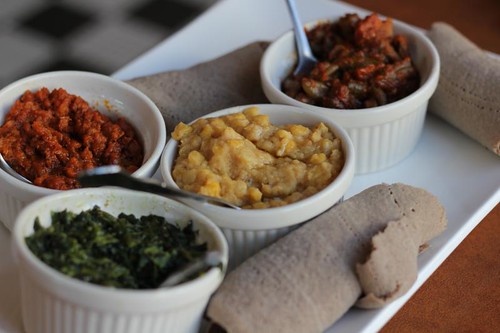
But the interesting thing to look for on the menu is the page with the small selection of Ethiopian dishes. There’s not a lot, and I can’t swear that they make this stuff here (though it’s the kind of big-pot-of-stew stuff pretty much anyone could make). But what we had was pretty likable; Cathy Lambrecht and I ordered a vegetarian sampler for about ten bucks and got four bowls of different stews with injera (a spongy flatbread which you use to scoop the stews up). The red lentil one was my favorite, full of deep meaty flavor (though it’s meatless) and multileveled moderate heat; at the complete opposite end, the mild, comfy corn one was also good in a corn pudding-like way.
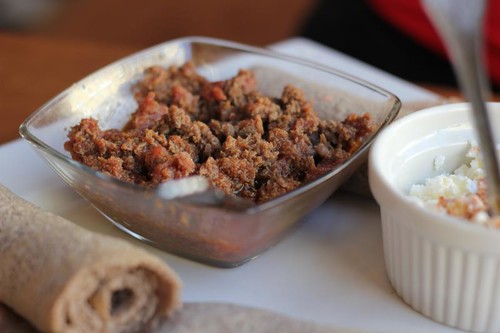
Cathy also wanted to order kitfo, the chopped beef tartare dish which is common throughout that part of the world. I wasn’t wild about a big plate of raw beef, but indulged her— and as it turned out, it wasn’t a big plate of raw beef, because it seemed to have sautéed before serving. The result, served with a white cheese, was a bit like eating the meat made with a packet of McCormack Taco Seasoning without the rest of the American taco, but it wasn’t bad.
African cuisine can be hard to get into— you have both food and dining rituals you are likely unfamiliar with— so I didn’t mind at all this light immersion into it in the setting of a bright, welcoming coffee house with a friendly, fairly attentive server. And the coffee’s very good; some time when I need to hang out by my kids’ school, I’ll be back, exploring Africa with laptop and coffee mug.
Brothers Coffee, 4720 N. Kedzie
I read some reviews of this place online— it sounded like a hopping coffee shop with an Arabic flavor. I formed a picture in my head of a place which combined Wicker Park barista skills with a middle-eastern souk feel, drawing a busy crowd of North Park University students perhaps; so one Sunday morning, I headed there with my son.
The reality proved to be an empty storefront consisting of a counter with the usual third world grocer offerings— phone cards and the like— which gradually became the proprietor’s living room as you moved toward the back. The bustling coffeeshop of my imagination was nowhere to be seen. Leaving his TV and cigarette the proprietor walked up to greet us, perhaps slightly mystified as to why we were there, but welcoming and friendly nonetheless.
There were the usual Bunn coffeemakers and warmers, but they were not in use that day, nor was the small espresso machine. I ordered a coffee, which he proceeded to draw from a countertop coin-operated machine which promised Jerusalem Coffee. The result was the most sugar-filled drink I have ever tasted. It was like drinking warm brown insulin. I know they like coffee and tea sweet in the middle-east, but do they really drink it this way in Jerusalem? Arthur C. Clarke once wrote a story about the discovery of life forms on the sun and the melancholy realization that there was life which we could never know, because it existed at temperatures that kept us at an unbreachable distance. That’s how I feel about the coffeehouse culture that can drink coffee this sweet— it will forever be a closed book to me.
I told the guy sorry, I just can’t hack this stuff, I’ll pay for it but maybe you could make, you know, a pot of American coffee in the American coffee pot? For some reason this was not possible because it would take 20 minutes. Instead he made me Turkish coffee. At least here I knew the drill— you have to wait for the grounds to settle into silt at the bottom if you don’t want a mouthful of grit. But was it to be that simple? Of course not. He had some kind of cardamom-flavored coffee— this was proudly shown to me, to let me know I was going to have something special— and where the coffee grounds would eventually sink, the tiny bits of cardamom would not. You couldn’t drink it without getting a mouthful of seeds and stems, basically.
When he wasn’t looking I poured most of it into the other cup, as if I’d drunk it and enjoyed it, and paid my bill. (My son had hot chocolate, uneventfully.) For $5 I’d had an education in the limits of cultural exchange, I guess, if not yet my morning coffee. But I remain baffled where the place I’d read about online was, and how others had found something to enjoy in a place that had completely defeated me.
Tags: brothers coffee shop, coffee, royal coffee
Totto Ramen in New York.
For a long time I didn’t get why ramen was such an object of hype and obsession among foodies. It’s not that I associated it with the 50-cent packet kind— I’m not sure I’ve ever even had that. But to me it was soup, so it had noodles, and broth— and so do a lot of other things. Yet only ramen attracted the kind of mania that not only searches for perfection but, unfortunately, often uses food as a cudgel to lord it over someone else with—

“Think you know ramen, my droogies? You’ve never had the real horrorshow ramen from Vancouver, ya great stinking globs!”
But authentically-made ramen took off here last year and this year the way Neapolitan pizza did a few years ago, and ramen keeps forcing itself on me. And I guess I get why it’s such good material for obsession now— it’s super-simple, but each of its components can be debated to the end of time— is the broth porky enough? The noodles chewy enough, or not too chewy, or springy or wheaty or whatever you think the key attribute of noodles ought to be?
In New York I went to Totto Ramen, and its toothy noodles and deep, porky-funky broth seemed to establish themselves for me as at least one lodestar for what ramen ought to be— maybe you prize different virtues, but it gave me something to compare the others to. Next I had The Aviary’s ramen at an event I attended, and… well to be honest I’d tried too many Aviary cocktails by that point to be in full reviewer mode, but it seemed in the same ballpark. So from there, I was off and ramen, trying it wherever I could…

Can you believe I had never been to Ginza for sushi? (Oops, I still haven’t, actually.) I used to work in that area but frankly, sushi restaurant in skid row hotel scared the hell out of me in the 90s, before I was a Chowhound and fearless. I popped in there after a Key Ingredient shoot or something downtown and found it exactly the place I should have been going to all along, a 60s restaurant in Japanese Danish modern conjuring up a whole lost world of salarymen trying to push cheap Made in Japan gear at the Merchandise Mart, where the sushi chefs expertly prepare your fish while ignoring your gaijin ass and talking baseball in Japanese (you could recognize the occasional player name). The ramen wasn’t deep or profound, but it was like good diner food in its comforting reliableness. I’m going to have to go back for sushi now.

Back in the dotcom era, when I worked in the converted warehouses of River North, Cocoro Restaurant seemed a very sleek and chic modern Asian spot for lunch, specializing in shabu-shabu (hot pots in which you cook thinly sliced meat and vegetables yourself). Returning to it after a decade, it seemed much more homey and down-to-earth. So is that the inevitable fate of even today’s glitziest Asian spots? Will Japonais or Jellyfish someday seem as corner-diner easygoing as this place does now? Well, only if they get someone as warmly welcoming as owner Yuko here, who came by my table dispensing a warm smile every time; funny that I had not picked up on the place’s real attraction long ago. Anyway, ramen is good if not as deeply funky as the very best; pillow-soft tofu in a well-rounded udon was better.

All those ramenheads and their droogies have praised Santouka, the only Chicago outlet of a Japanese chain also on the west coast, located in the Mitsuwa Japanese shopping mall in Arlington Heights. I expected it to be the bee’s ne plus ultra, but I found the broth less rich than many of the above— which forced me to reconsider whether that was another model of ramen I should be respecting, and the deepest of the others had been too heavy-handed. Or maybe it’s just mall food court Japanese and I shouldn’t expect so much of it.

Whatever, this ramen has an ace in the hole that none of the others so far had. For a $3 upcharge they’d put slices of pork cheek in it. A lot of slices of pork cheek. Which was as soft and supple as something really soft and supple. This was one sensual bowl of ramen.
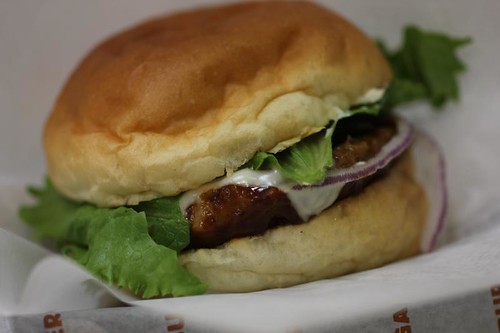
While there I wanted to try something else that’s comparatively (ie last year or two) new to Mitsuwa— Gabutto Burger. It’s a Chicago guy who set out to make, I guess, a Japanese burger. And it is, to be honest, something of a lesson in how you may, or may not, get what’s going on in some other culture’s classic dishes… like, say, ramen. There’s mayonnaise, not surprisingly in a Japanese dish, and also a kind of beef jus that is like what you’d get in a pot of braised beef or pot roast or something. Add that the patty is all kind of one texture, and to me this just misses what burgers are about to Americans— that unique contrast of crispy seared beef with the sweet and sour of ketchup and mustard.
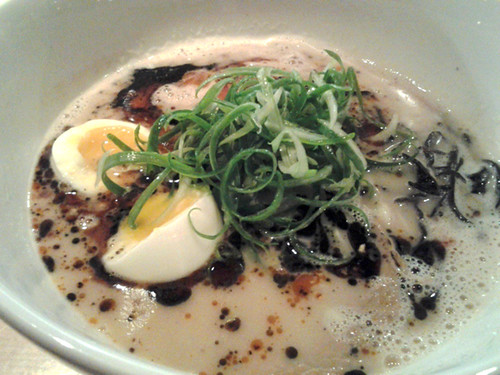
Oiistar is a hip new place in Wicker Park, the inside is done in blocks of raw wood (uncomfortably, in the case of the one you sit on) like a Bill Kim belly joint, and unconventionally in terms of what the ramen is like. Which is to say, there isn’t a normal bowl of ramen to be had here— the simplest one (the Oiimen) is still dressed up with fried garlic and chili oil, and that’s before you get to things like the Pozolmen with its jalapeño and tomato. Spice is often used to cover up inferior quality, but I managed to dredge up an un-chili oiled spoonful with the comically large spoon they give you, and it seemed a thoroughly respectable broth with good porky flavor; the noodles, thin and as curly as a phone cord, were good enough but I like a little thicker and chewier noodle. Entirely decent in an Americanized-concepted way— though for what it’s worth, at $14 it was also surely the most expensive as well. Even without strips of pork cheek. Oii vey!
* * *
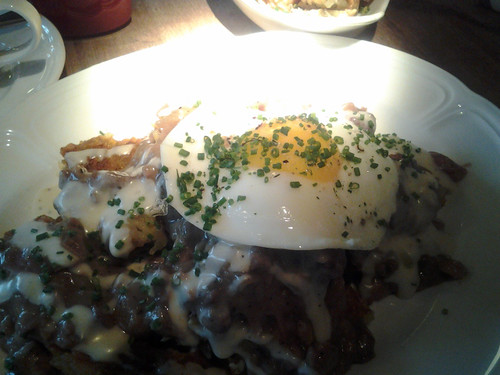
This looks like a bad flash picture, but actually the dish was sitting right under the spotlight that shines brightly on the middle of your table at Au Cheval, apparently in case you have to suddenly perform open heart surgery on a hamster during your meal.
I remain, to judge by its regular appearances in my Twitter feed, the only person who doesn’t love the Au Cheval burger. I’ve meant to go back to give other things a try and see if I liked the restaurant as much as, say, Michael Nagrant, who found the duck heart gravy hash one of the greatest things ever… but it can be a little harder to motivate yourself for an experiment confirmation rather than a meal. I wound up there one Sunday morning when I drove by Little Goat Diner, saw no big line waiting, went and paid a bunch of money to park, walked over to it with my son… and was promptly told there was an hour and a half wait. How could the six people in the entry way add up to that? Then I remembered a vague mention of buzzers. The other 60 people in front of me must be on the Little Goat Bread side, sipping coffee and waiting for their buzzer to go off.
With so much money sunk into parking, I tried to find somewhere else to go in the area— and what did you know but we were 2 minutes from Au Cheval opening for brunch. Unlike last time, when they seemed vaguely baffled by my presence as a customer, they were friendly as could be, albeit, there was still a slight sense that they believed that they were not so much servers as people who were playing servers on TV, or possibly in a department store window. In sunlight, the dark bar was still dark and hardly diner-y, but it was at least possible to see one end from the other. It was quiet enough, at least at first, that I could actually hear the music playing from the reel to reel tape player in the front. Was there an audio difference? It did seem quite clear and rounded, natural in its tones….
I took Nagrant’s advice and ordered the thing I had planned to eat the next time I went there, the duck heart hash, luckily on the breakfast menu. Which is to say, I ordered mounds of potatoes, a peppery gravy studded with braised duck heart, and egg, while my son had their aptly-named Simple Breakfast. Again, excess was the order of the day— his eggs were Scrambled Butter— but this time I could see expertise and skill and something of a guiding hand making composed dishes, not merely piling it on. The sweet, thick-cut bacon was terrific, the gravy was deep with flavor; the hash was fried perfectly into too-neat perfect squares, the egg was exactly at the runny point it should be. On its own terms, nailed.
Yet I have to say that I still can’t fully buy into Au Cheval’s indulgent, eat-like-a-teenager ethos (which is also, at least partly, that of sister restaurant Maude’s Liquor Bar as well). I loved a vegetable I had at Maude’s (brussel sprouts), yet the idea behind all of this food seems to be to allow you to gorge on the fun stuff with no balancing from any other food group— and ultimately that’s a lifestyle too one-dimensional for me, at least very often. There’s some of that relive-your-childhood-way-of-eating at another popular new restaurant, The Trenchermen, what with pickled tater tots and so on, but somehow it always takes a turn there that acknowledges you can’t go home again and you are an adult who expects tastes of adult complexity. There’s nothing complex about Au Cheval; it plays all its cards up front. The first bite tastes indulgently, belly-rubbingly pleasurable, and thirty bites later, you’re still eating the exact same thing and experiencing the exact same feelings from it, a lot fuller.
* * *
The short life of an Andersonville restaurant called Premise, which took place within a few months of 2012, prompted media question-raising about whether modernist or exotically nose-to-tailish food could ever make it in the neighborhoods rather than downtown (even though, presumably, it’s pretty much the same people eating it in both places). What no one seemed to notice was that Storefront Company, which opened around the same time, was buzzing along fairly successfully doing just those things in Wicker Park without much hype or angst.
I went there early on and found it a little more squiggles than substance, like a hotel restaurant’s version of trendy food, but with some strong points (a very good cheese program for a neighborhood spot, a terrific savory-sweet dessert based around parsnips which could have come from Schwa). But by around the one-year mark chef Bryan Moscatello seems to have grown into his own comfort level with modernist food, making use of everything in a matter-of-fact way so that it doesn’t scare off the locals when a slice of pickled rabbit heart decorates a neat plate of geometric bits of food, in all its biology-textbook detail. Nothing is too out there, which maybe means it never quite scales the highest heights either, but for a relatively affordable, comfortably chic spot alongside pizza parlors and nail salons, it demonstrates a lot of confidence with the direct flavors of house-butchered whole animals. (Vegetables seem rather an afterthought— but dessert is not.)
Disclosure: Storefront Company was a media dinner; the Aviary ramen was part of an event I attended as a media guest; everything else was eaten like a normal person.

 Posted in
Posted in 




